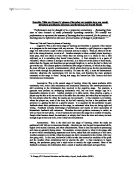The cognitive stage involves the performer gaining an understanding and creating a mental picture of the required action to form an exclusive motor programme. The theory suggests that this is the initial stage. Information is provided by the coach in the form of demonstrations, video footage, pictures, posters or verbal instruction. The performer receives extrinsic feedback from the coach, directing then towards a specific goal, as they have yet to develop a full understanding of the movement requirements. Although beginners may know that they are doing something wrong, they are generally not aware of exactly what should be from the coach doing differently the next time to improve. The length of this phase is generally short as performers quickly retain or dismiss actions when appropriate.
The second stage of learning in the Fitts and Posner model is called the associative stage. This involves the performer physically implementing the motor programme learned in the cognitive phase of learning. The theory suggests that this is the intermediate phase. The skill learned is refined and gross errors eliminated through repeated practice, developing an effective and consistent technique. As kinaesthetic awareness of the movement develops, the performer is able to provide internal feedback as they have developed an ability to detect some of their own errors in performing the task to supplement any external information. The timescale before progressing to the autonomous stage of learning may vary depending on the level of ability, complexity of the task, type of practice and quality of feedback. At this stage variability of performance from one attempt to another also begins to decrease. After much practice and experience with the skill, the learner moves into the final stage of learning, the autonomous stage.
In the autonomous stage the performer demonstrates the ability to complete skilled actions with increased efficiency, accuracy and speed involving little conscious control. The theory suggests this is the final stage of learning. The information processing time is reduced and distractions have less effect on performance. Highly skilled golfers concentrate on the ball and some of the specific adjustments that they must make in their normal swing to produce a particular shot. Highly skilled dancers do not think about the individual steps of the routine, for they have become automatic. Instead, they have learned to concentrate on some of the more critical phases of the routine that are particularly difficult or that indicate that some major change in the routine is to begin. The performer has the ability to analyse their own actions, allowing external feedback to be used to develop finer points of technique, strategies and tactics. In order to maintain their performance at this phase, practice must continue. In this stage the variability of the day-to-day performance has become very small.
This does not mean that learning stops or that the individual ceases to make errors but rather that there ceases to be the need for conscious attention to the motor act itself. Thus, the highly skilled tennis player is able to serve without having to concentrate on the particular fundamentals of the serve, on how to hold the racket, toss the ball, and so on, but can concentrate on what is needed to produce a serve that will land in a particular part of the service court. It will help you to think of the three stages of the Fitts and Posner model as parts of a continuum of practice time. There is a gradual changing of the learner's characteristics from stage to stage. It is often difficult to detect which stage best represents an individual at a particular moment, especially when that individual is in a transitional state, moving out of one stage and into the next.
To enhance a performance from a sportsperson you must structure the practises properly. When a coach starts to teach a learner he or she must discover what phase in the Fitts and Posner theory the performer is at. Because it’s a learner is most probable that they are going to be the cognitive phase of learning but if the performer has played a similar sport they may be at a stage further. Once the coach has figured out what phase the performer is at then he/she needs to think about what type of practices they are going to use. If the learner is at the cognitive stage then the game must be explained to start of with and then the different motor skills must be broken down into small parts. The learner will need a lot of visual or manual guidance to begin with. For example- Basketball
The coach could chose from different method including whole method, whole-part-whole method, Part method or progressive part method. I would choose the Progressive part method; I would explain the simple rules and of the sport to the performer then break down the different motor skills involved in the sport. Each skill is broken down into sub-routines, which are practised in isolation and well learnt. Part one is learned then part two are joined together; part three is then learned in isolation and then added top parts one and two. This is particularly effective for learning how to do a lay up. This is a very good method because the weaknesses can be targeted more easily, practised and improved.
Bibliography
-
Physical education and sports studies- Advanced level student revision guide 2nd edition
- Oxford PE revision guide (A LEVEL)
Word count: 1,179







